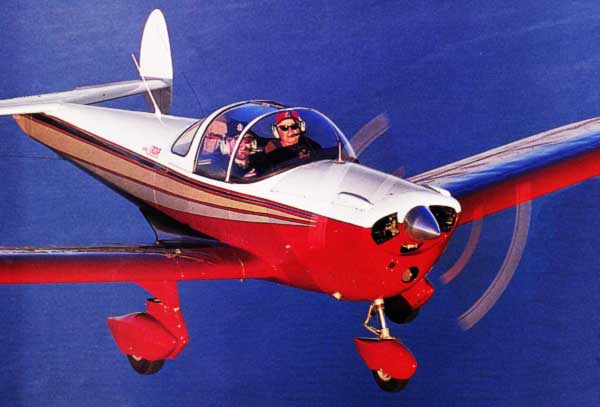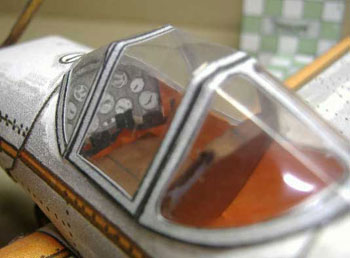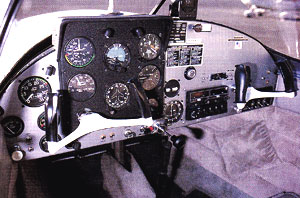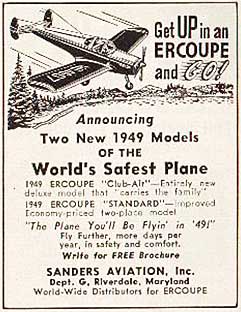

Ercoupe - $$4.95
The ERCO Ercoupe is a low wing monoplane first manufactured by the Engineering and Research Corporation (ERCO) shortly before World War II, production continued after WWII by several other manufacturers until 1967. It was designed to be the safest fixed-wing aircraft that aerospace engineering could provide at the time, and the type still enjoys a very faithful following today.
Classic Ercoupe


Arguably one of the most overlooked private plane in history. It first flew in 1938 and was built again after WWII.
The brilliant engineering that went into this plane made it safe and easy to to fly but still it was a marketing failure.
Say, I believe the original "flying milk stool" wasn't a Piper. Some folks may have referred to the Tri pacer as such due to Photo right by Wayne White, This model is best when printed on silver inkjet paper
 The tricycle landing gear but it wasn't
the first plane to bear that nickname. I'm trying to remember
the name but it was a low wing 2 place all metal plane with
a bubble cockpit and rudders out on the end of the horizontal
stab and the ailerons were linked to the rudder. The combination
of the unusual rudder arrangement, the linked controls, and
a tricycle gear gave it the nick name the flying milk stool.
The tricycle landing gear but it wasn't
the first plane to bear that nickname. I'm trying to remember
the name but it was a low wing 2 place all metal plane with
a bubble cockpit and rudders out on the end of the horizontal
stab and the ailerons were linked to the rudder. The combination
of the unusual rudder arrangement, the linked controls, and
a tricycle gear gave it the nick name the flying milk stool.
I finished a 'do' of your Ercoupe, from way back in the Mudget/Fynn days--in Red River Silver, of course. Don't know if you are aware of this, but there is a serious discrepancy between the upper and lower wings parts. At 1/40 the lower wing is about 3/16 shorter than the upper if you line up the landing lights. You may want to check this out--or not, in your present turmoil. There is, of course, the matter of the pretty crude nose, but if you ever redo the whole plane I'm sure this will be taken care of. John
Erco Ercoupe
 The Ercoupe (E and R coming from the company's name: Engineering
and Research Corporation) was one of the most unusual-and controversial-light
airplanes ever built. It was designed by Fred E. Weick, one
of aviation's foremost engineers, who decided to solve with one
bold stroke the biggest single cause of aviation fatalities:
the stall, followed by spin, at altitudes too low to permit recovery.
The Ercoupe was designed to be stall proof and spin-proof. (The
same idea was executed, in a slightly different form, by Professor
Otto Koppen, of MIT. His design, called the Skyfarer, was also
stall and spin-proof, but it never reached volume production.)
The Ercoupe (E and R coming from the company's name: Engineering
and Research Corporation) was one of the most unusual-and controversial-light
airplanes ever built. It was designed by Fred E. Weick, one
of aviation's foremost engineers, who decided to solve with one
bold stroke the biggest single cause of aviation fatalities:
the stall, followed by spin, at altitudes too low to permit recovery.
The Ercoupe was designed to be stall proof and spin-proof. (The
same idea was executed, in a slightly different form, by Professor
Otto Koppen, of MIT. His design, called the Skyfarer, was also
stall and spin-proof, but it never reached volume production.)
The Ercoupe could not be ignored. The wing was placed low, there were two vertical fins on a horizontal tail boom, and the third landing wheel was under the nose. This design flew in the face of all things known about proper light airplanes, which had high wings, one fin (and rudder), and a tail wheel.
The Ercoupe really is a nice little plane though some pilots (mostly those who've never flown it) don't think it's too respectable. Most owners love them.
Both the Ercoupe and Skyfarer were built in small quantities before World War II. After the war the Ercoupe came on strong, and was promoted as no airplane had ever been promoted before. It was displayed at state and county fairs, demonstrated at air shows, flown from shopping center parking lots, and even dismantled and reassembled inside department stores. The results were satisfying, to say the least, and Engineering and Research Corporation had to expand their production facilities several times before they could catch up with the demand.
|
How to mystify your modeln' pals....


Here are three Ercoupe photos you might be able to use. Printed on Wausau 90 LB Exact Index paper resulting in an eight inch wingspan. 
Though there is no print showing, the back surface was given a protective coating of Krylon Acrylic Clear prior to cutting out the parts. This helped keep the surface clean. Bob Penikas



Modeln Pal, Bob Martin, has figured out how to make fabulous clear windscreens and even complex canopies using common clear packing tape. Its easy !! Step by Step instructional
 |
|
 Here are three Ercoupe photos you might be able to use. Printed on Wausau 90 LB Exact Index paper resulting in an eight inch wingspan. |
 Though there is no print showing, the back surface was given a protective coating of Krylon Acrylic Clear prior to cutting out the parts. This helped keep the surface clean. Bob Penikas |
 |
 |
 Modeln Pal, Bob Martin, has figured out how to make fabulous clear windscreens and even complex canopies using common clear packing tape. Its easy !! Step by Step instructional |
|
All of this took place with absolute disregard of what aviation's old timers were saying about the airplane. Because of its tricycle gear, they called it "the flying milking stool." Because its ailerons and rudder were interconnected-there was only one pedal, for brakes, on the floor-the old timers spoke darkly about the problems of landing in a cross wind. (In fact, there were almost none: the landing gear was sturdy, and would accept a very high level of cross wind and a correspondingly low level of pilot skill.)
The Ercoupe was noticeably faster than its contemporaries and quite comfortable and easy to fly. One nice touch was that the cockpit canopy could be opened in flight (at some speed penalty), producing much the same sensation as driving a convertible with the top down. It was a nice looking, all-aluminum machine, once one got used to its unconventional design. It was precisely true that it would neither stall nor spin.
Even so, it was soon found to have a serious fault. It would get into a high rate of descent (or "sink") which could only be stopped by full forward yoke and loss of a considerable amount of height. The usual result was a hard landing and expensive airframe damage. Injuries to the occupants rarely required medication, but the experience was unsettling enough to drive some new pilots out of aviation.

Fred Weick's goal of eliminating the stall-spin accident sequence was achieved, but the airplane was badly oversold. The high sink rate was never mentioned. In fact many salesmen were themselves surprised by it. The major thrust of the sales effort was "anyone can fly," and cases without end were cited in which pilots who had never had a previous lesson soloed in two hours, or three, or even one.
When the postwar airplane sales bubble burst, Engineering and Research Corporation was not alone in disaster, but unlike Beech, Cessna, and Piper, it did not survive. The Ercoupe itself refused to die and went through a series of revivals, with each new group of owners as starry-eyed as the last, certain that they could escape the fate which had overtaken their predecessors.
Unfortunately, none of the attempts succeeded, not even the most recent revival by Mooney Aircraft, who bought all rights, tooling, and parts from Alon Aircraft, which had been building a few at a time in Kansas. This time the resurrectors took the approach that the only thing wrong with the Ercoupe was its stall-proof, spin-proof philosophy. The tail was redesigned, using one fin and rudder. Rudder pedals were made standard. (A previous field modification had permitted adding rudder controls to the original.) All of the engineering tricks which had made the Ercoupe stall proof and spin-proof were undone.
The Cadet, as the reincarnation was called, no longer looked odd: by now, low wings and tricycle gears had become commonplace, and that double fin was gone. The Cadet flew just like other airplanes, given small differences in handling. It would stall, and it would spin. The attempt failed: the Cadet didn't even show the small spark of life visible in the previous tries.
The unfortunate part of all this is that the Ercoupe is really quite a nice small airplane. The freedom from stalls and spins doesn't hurt, and anybody who wants to can have rudder pedals installed. The high sink rate can be avoided, as it is in all other airplanes, by proper pilot training and technique.
The one remaining Ercoupe problem is social: it is not thought to be a respectable flying machine. Most of those who have this attitude have never flown one and have no idea of its real assets and liabilities, but that does not lessen their scorn. The Ercoupe is worth looking at, even so.
The Great Silver Hope
Masquerading under the Ercoupe, Alon, and Mooney labels, the Ercoupe design has been around much longer than most people realize. The Ercoupe was designed to a lofty concept and high level of sophistication....and did exactly what it was designed to do. It's roots go back to the early 30's when it was popular to believe that there would someday there would be a mass market for "Everyman's Airplane". Further, it was believed that the great mass market awaited only the appearance of a cheap, easy-to-fly and safe airplane.
In 1936 Fred Weick was a young engineer hired by the just formed ERCO (Engineering Research Company) and is generally regarded as the creator of the legendary 1937 Ercoupe. All through the initial design and testing, wind tunnels were not used at all. The airplane was flown, modifications made to correct deficiencies, then flown again and again until it was certified on April 20, 1938. A placard, which was the first for any airplane, was allowed to be placed proudly on the instrument panel reading: "This aircraft characteristically incapable of spinning"
Things looked rosy for the Ercoupe but then the Second World War came along and production was halted for lack of aluminum . Sadly, just 112 Ercoupes came off the line.
EPILOGUE
After the war, it became evident that there simply wasn't an "Everyman's Airplane Market" and possibly might never be. The Ercoupe is, arguably, the best tested, best designed, and best researched light airplane ever produced. Even today it has few peers and it's only failure was that it was produced for a non-existent market. Look for one at your local airport.
The first JATO (Jet Assisted Take Off) was an Ercoupe which led to the foundation of the Jet Propulsion Laboratory.
The Ercoupe, with its distinctive twin-tail design, was originally provided with "coordinated controls", i.e. the rudder was connected to the yoke and yaw correction was automatic - NO RUDDER PEDALS. The steerable nose wheel was connected directly to the yoke - you taxied exactly like you drive your car. This, and limited elevator travel, contributed to the result that the 'Coupe is "characteristically incapable of spinning"! You can try, but the plane will fly out of an incipient spin. An entirely new category of pilot license was created for the thousands of new pilots who had never seen a rudder pedal. This plane was designed pre WW2 and didn't get into real production till 1945 when thousands were sold through such esteemed aviation outlets as the Men's Department at Macy's!!


"Rudder Kits" were available to convert the plane from 2-control ("coordinated") to 3-control ("conventional"). Landing a 2-control 'Coupe is an "interesting" experience!! You crab it into the wind and land that way!! The nose wheel will caster and straighten it out ON THE RUNWAY. Another historical fact: all original Boeing 707 pilots were taught to land in the 'Coupe - the 707 had a similar problem - the low hanging engines meant that you couldn't drop a wing into a crosswind - you had to land them crabbed!! The Ercoupe's gear does not swivel, a common misconception, but the geometry causes the airplane to turn in the direction of forward motion. If you fight this tendency you can ground loop.]
Mooney built the last 59 with a "Mooney tail" instead of the distinctive twin tail of all previous production. This, and other changes, created an airplane which could stall and spin with the best but also lost a lot of performance. It was their intention that the M10 Cadet be their "trainer".
"Alon" was an interesting bit of history: While Forney was building the 'Coupe, one company which came mighty close to buying the type certificate was Beech!! John Allen (Beech plant manager) and Lee Higdon (Beech accounting manager) felt strongly that Beech should take it on, but Olive Beech got cold feet and said no. So they quit and setup the Allen-Higdon (ALON) company to do it. They were so impressed with the plane that they bought the company!!
Alon made a number of speed/power changes to the airplane and reverted to providing rudder pedals as standard, with the 2-control by special order only. They changed from vertically sliding window entry to a sliding canopy. Some people dump on 'Coupes. It's unfair and ignorant criticism, but it keeps the prices down and the secret in the family!! If you ever have to opportunity to fly a 'Coupe - try it!!
The Ercoupe has climb and cruise performance very similar to the performance of a Cessna 150 - but it drops like a rock when the power goes off. The best thing about a 'Coupe is you can fly it with the sliding windows down.
Looking at the front view (above), notice that the Ercoupe has a very distinctive forward fuselage shape that narrows toward the bottom. Curiously, the reason for this shape was to accommodate the ERCO inverted inline engine that was custom built for the Ercoupe. The Continental A-65 was ultimately used and the fuselage remained unchanged. Refer to the typical cross-section. Yes, the nose section IS larger to permit engine cooling air to escape. Keep dihedral in mind as you glue the wing center section in place. It's hard to add it as an after thought later. I mean bending the wings up is really dumb. Carefully curve and bend the wing fillets out BEFORE gluing the wings to the fuselage. A pencil is a good diameter over which to shape the fillets. |

Rocket-Assist Takeoff
On Aug. 12, 1941, the first Air Corps rocket-assist
takeoff was made by a Wright Field test pilot,
Capt. Homer Boushey, using a small civilian-type Ercoupe airplane.
Subsequent refinements of this
technique were made for assisting heavily-loaded airplanes in
taking off from limited space. This
technique is still used whenever needed. Takeoff of Ercoupe airplane
in much less than
normal distance due to firing of rockets attached under its wing.
For comparison, the light plane in
the foreground although equipped with an engine of approximately
the same horsepower as the
Ercoupe, had just lifted off the ground at the instant the photo
was taken.
|

 |
Cockpit of the Erco Ercoupe. |
 |
Erco Ercoupe Factory during its post war heyday. |
Specifications for the Ercoupe
 |
Crew: 1 Capacity: 1 passenger Length: 20 ft 9 in Wingspan: 30 ft Height: 5 ft 11 in Wing area: 142.6 ft² Empty weight: 749 lb Useful load: 511 lb Max takeoff weight: 1,260 lb Powerplant: 1× flat-4 engine, 75 hp at 2,300 rpm Performance Never exceed speed: 144 mph Maximum speed: 110 mph Cruise speed: 95 mph Stall speed: 48 mph Range: 300 mi Service ceiling: 13,000 ft Rate of climb: 550 ft/min Wing loading: 8.83 lb/ft² Power/mass: 0.13 hp/lb |
 |
|||
| A: The Ercoupe twin tail was chosen for its 'anti' Spin characteristics | B: The strong, all aluminum fuselage was easy and inexpensive to build. | C: The full, slide back Ercoupe canopy afforded perfect visibility over the low positioned wings | D: Very rugged landing gear made flying out of small rough fields possible. |
 |
On April 11, 2009, at 1450 central daylight time, an Engineering and Research 415C (Ercoupe), N87384, was destroyed by a post crash fire after it impacted terrain about one mile north of the Woodlake Airport (IS65), located in Sandwich, Illinois. The sport pilot and passenger received fatal injuries. Meteorological conditions prevailed at the time of the accident, and no flight plan was filed. |
Aircoupe (sic)







